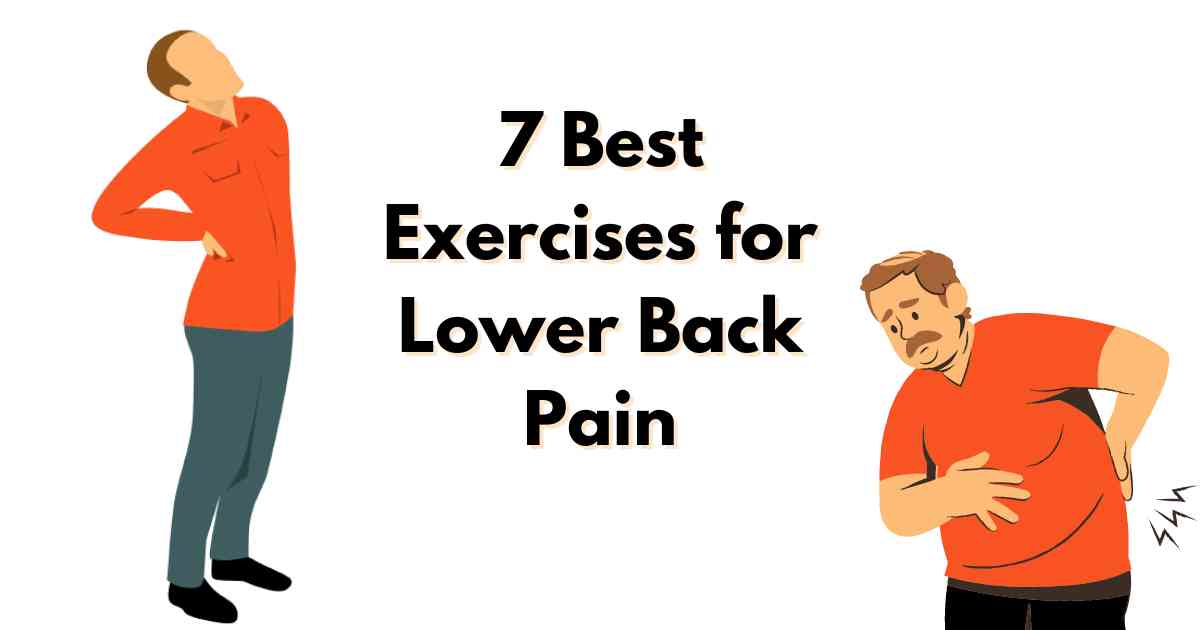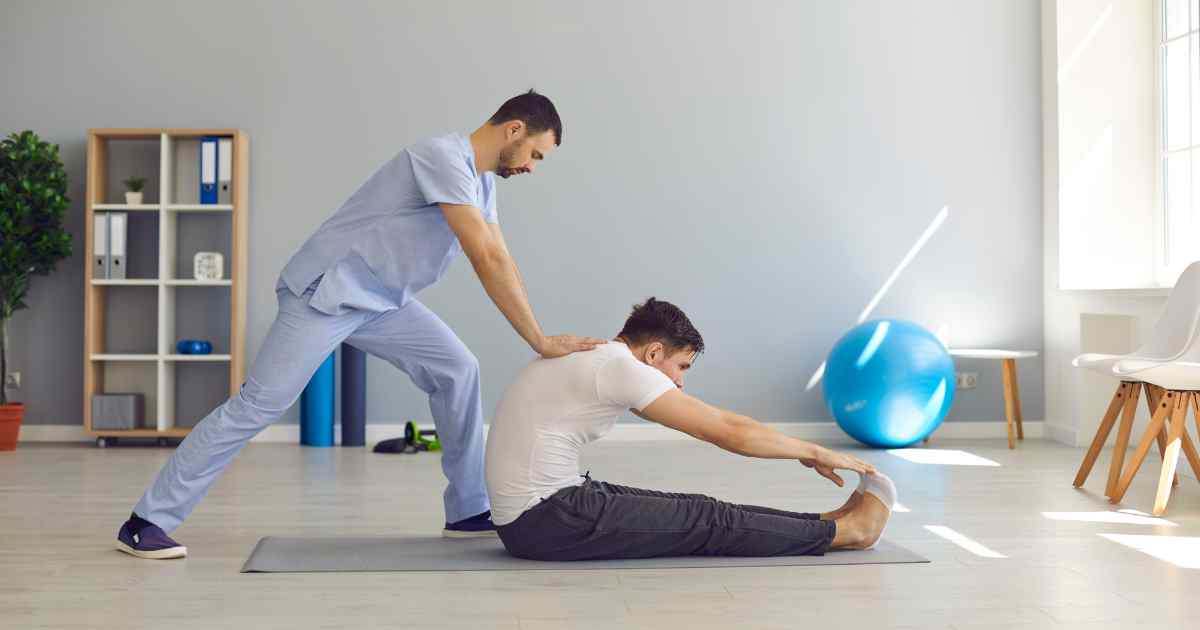Are you tired of constantly dealing with lower back pain? The good news is that incorporating specific exercises into your daily routine can help alleviate and prevent lower back pain caused by poor posture, muscle strain or sprained herniated discs sciatica spinal stenosis, and osteoarthritis.
In this comprehensive guide, we will explore the most effective exercises for back pain and how they can help you achieve better spinal alignment, reduce muscle tension, and promote overall lower back health. By incorporating these exercises into your routine, you can experience relief from lower back pain and improve your overall mobility and flexibility. So, let’s get started and learn more about these exercises!

What is Back Pain? Its Symptoms, Common Causes & Effective Treatments
7 Best Exercises for Lower Back Pain
Lower back pain is a common problem that can be alleviated and prevented through exercise. Here are some effective exercises for it.
1. Cat-cow stretch:
The Cat-cow stretch is a popular exercise that can help reduce lower back pain. It involves getting on all fours, arching your back towards the ceiling (Cat pose), and then lowering your back towards the floor while lifting your head and tailbone (Cow pose). This gentle movement helps stretch and mobilize the muscles in the lower back, reducing tension and increasing flexibility. Incorporate Cat-cow stretches into your daily routine to alleviate it and improve overall mobility.
2. Child’s pose:
If you’re looking for exercise to relieve lower back pain, Child’s pose is an excellent choice. This yoga pose involves kneeling on the floor with your arms extended forward and your forehead resting on the ground helping to stretch the lower back hips and thighs. It is a relaxing exercise that can also reduce tension in the lower back and promote relaxation. Incorporate the Child’s pose into your daily routine to alleviate it and improve flexibility.
3. Pelvic tilt:
The pelvic tilt is one of the most popular exercises for lower back pain. This exercise is excellent for strengthening and stretching the lower back muscles, reducing pain and discomfort. Pelvic tilt involves lying on your back with your knees bent and feet flat on the floor then tilting your pelvis upwards towards the ceiling. It is a simple and effective exercise that can be done anywhere and is highly recommended for anyone with this pain.
4. Knee-to-chest stretch:
The Knee-to-chest stretch is a simple yet effective exercise for lower back pain relief. It involves lying on your back with your knees bent and feet flat on the floor then bringing one knee towards your chest while keeping the other on the ground.
This stretch helps to stretch and elongate the lower back muscles, reducing tension and promoting flexibility. Knee-to-chest stretches can be done anytime and anywhere making them an ideal exercise for anyone looking to alleviate it.
5. Glute Bridge:
The Glute Bridge is a fantastic exercise for reducing lower back pain and strengthening the lower back muscles. It involves lying on your back with your knees bent and feet flat on the floor, then lifting your hips towards the ceiling while squeezing your glutes.
This movement engages the lower back muscles and promotes strength and flexibility in the lower back region. Glute bridges can be done almost anywhere and are an effective exercise for anyone suffering from lower back pain.
6. Plank:
The Plank is a simple and effective exercise that targets the core and lower back muscles, reducing lower back pain. It involves holding a push-up position with your arms extended and your body in a straight line from head to heels. This exercise helps to strengthen the muscles that support the lower back, improving stability and reducing the risk of injury. Planks can be done almost anywhere and are an excellent addition to any lower back pain relief exercise routine.
7. Walking:
Walking is a low-impact exercise that can be an effective way to reduce lower back pain. Walking regularly can improve the strength and flexibility of the muscles in the lower back and improve overall posture. It is also an excellent way to improve cardiovascular health which can further reduce the risk of it. Walking can be done anywhere, making it an accessible and practical exercise for anyone looking to relieve lower back pain.

Benefits of Lower Back Pain Exercises
It can be debilitating and affect every aspect of life. However, incorporating exercises for lower back pain into your daily routine can offer numerous benefits, from reducing pain and discomfort to improving overall physical function and well-being. Here are some effective benefits for lower back pain.
- Improved lower back strength and flexibility, reducing the risk of injury and strain.
- Reduced lower back pain and discomfort, improving the overall quality of life.
- Improved posture and spinal alignment, reducing the risk of developing chronic lower back pain.
- Increased mobility and range of motion, improving overall physical function.
- Improved core strength, providing support and stability for the lower back.
- Improved circulation and oxygenation of tissues, promoting healing and reducing inflammation.
- Reduced stress and tension in the lower back, improving overall physical and mental well-being.
- Increased ability to perform daily activities with ease, improving the overall quality of life.
- Reduced dependence on medication and other interventions, promoting a more natural and sustainable approach to pain management.
- Improved overall physical fitness and well-being, reducing the risk of developing other chronic health conditions.

Lower Back Pain Causes
It can be caused by various factors such as poor posture, inactivity, muscle strain or sprain, herniated discs, sciatica, spinal stenosis, and osteoarthritis. However, exercises for lower back pain can help alleviate the pain and discomfort caused by these conditions.
Poor Posture: Poor posture is a common cause of it. Sitting or standing in a slouched or hunched position can put undue stress on the spine and its supporting muscles leading to discomfort and pain.
However, incorporating exercises for lower back pain, such as stretches that improve spinal alignment and strengthen core muscles can help correct poor posture and reduce lower back pain.
Inactivity: Inactivity is another leading cause of it. A sedentary lifestyle can weaken the muscles supporting the spine and lead to stiffness resulting in pain and discomfort.
Incorporating exercises for lower back pain into your daily routine such as stretching and low-impact activities like walking can improve flexibility and strengthen the muscles in your lower back reducing the risk of pain and injury.
Muscle Strain or Sprain: Muscle strain or sprain is a common cause of it. However, incorporating exercises for it, such as gentle stretches and low-impact exercises, can help reduce muscle tension and improve flexibility. These exercises can also help prevent future strains and sprains, promoting overall lower back health.
Herniated Discs: Herniated discs can cause intense it, but exercises for it can help relieve symptoms. Gentle stretches and low-impact exercises, such as walking or swimming, can help strengthen the muscles supporting the spine, providing more support for the herniated disc.
These exercises can also improve flexibility and range of motion, promoting overall lower back health.
Sciatica: Sciatica is a painful condition caused by compression of the sciatic nerve. Incorporating exercises for lower back pain, such as gentle stretches and low-impact exercises, can help alleviate sciatica symptoms.
These exercises can help improve flexibility and strengthen the muscles that support the spine, reducing pressure on the sciatic nerve and promoting overall lower back health.
Spinal Stenosis: Spinal stenosis is a condition where the spinal canal narrows, causing pressure on the spinal cord and nerves. Exercise can be an effective way to manage spinal stenosis symptoms.
Strengthening and stretching the muscles in the lower back can help improve spinal alignment and reduce pressure on the affected area. Low-impact exercises like walking and swimming can also help maintain flexibility and promote overall spinal health.
Osteoarthritis: Osteoarthritis, also known as degenerative joint disease, is a common cause of it. This condition occurs when the cartilage that cushions the joints wears down over time, leading to pain and stiffness.
However, exercises for lower back pain can help alleviate the pain and discomfort caused by these conditions.
Conclusion
Incorporating exercises for lower back pain into your daily routine can greatly improve your quality of life. These exercises not only strengthen the muscles in your lower back but also help to reduce stiffness and increase flexibility.
By committing to a consistent exercise regimen you can reduce your risk of developing chronic lower back pain and improve your overall mobility. So why not start today and take the first step towards a healthier pain-free back?
Read More
- How to Perform Tricep Kickback -Benefits and Muscle Worked
- 7 minute workout-Benefits and Best Apps
- How to Get Started 30 Day Workout Challenge Plan
FAQ’s
Ques -1 Can stretching exercises help alleviate lower back pain?
Yes, stretching exercises can be effective in relieving lower back pain by improving flexibility, reducing muscle tension, and increasing blood flow to the affected area. It’s important to consult with a healthcare professional before starting any new exercise program.
Ques -2 What is the fastest way to relieve low back pain at home?
One of the fastest ways to relieve lower back pain at home is to do exercises specifically designed for lower back pain, such as pelvic tilts cat-cow stretches, and knee-to-chest stretches.
Ques -3 What exercises should I avoid with lower back pain?
If you have lower back pain, it’s best to avoid exercises that involve twisting or bending forward, such as sit-ups or heavy weightlifting. Consult a healthcare provider before starting any exercise program.